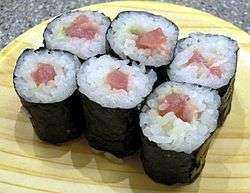Definify.com
Definition 2026
寿司
寿司
Chinese
| For pronunciation and definitions of 寿司 – see 壽司. (This term, 寿司, is the simplified form of 壽司.) |
Notes:
|
Japanese

| Kanji in this term | |
|---|---|
| 寿 | 司 |
|
す Grade: S |
し Grade: 4 |
| on'yomi | |
Alternative forms
Etymology
From 酸し (sushi, “sour”), the archaic し (shi) terminal-form conjugation of modern 酸い (sui, “sour”).[1][2][3]
Originally, sushi was a form of fish that had been salted and fermented for preservation without refrigeration. The fish was sometimes packed with rice or rice mixed with vinegar in order to speed the fermentation process. In the Edo period, this was also known as hayazushi (早鮨, 早鮓) when packed in layers, pressed, and fermented for just one night. Something similar is still prepared today as narezushi (馴鮨, 熟鮨) that relies on fermentation with no added vinegar.
The kanji are an example of ateji (当て字).
Pronunciation
- On'yomi
- (Tokyo) すし [sùshíꜜ] (Odaka - [2])[2][4][5]
- (Tokyo) すし [súꜜshì] (Atamadaka - [1])[2][4][5]
- IPA(key): [sɯᵝɕi]
Noun
寿司 (shinjitai kanji, kyūjitai kanji 壽司, hiragana すし, romaji sushi)
- sushi: vinegared rice served with fish or vegetables, etc.
Usage notes
Sushi may be counted a number of ways:
- Using the generic つ (tsu): 一つ (hitotsu), 二つ (futatsu)
- Using the generic 個 (ko): 一個 (ikko), 二個 (niko)
- Using the counter かん or 貫 (kan): 一貫 (ikkan), 二貫 (nikan)
Historically, かん or 貫 (kan) is apparently a relatively recent innovation, appearing in the 1970s. In the Edo period when modern sushi first starts to appear, and all the way through the Meiji or Taishō periods, records only show the use of the generic つ (tsu) and 個 (ko) counters.[6]
Derived terms
|
Proper noun
寿司 (hiragana ひさし, romaji Hisashi)
- A male given name
See also
- Appendix:Japanese sushi terms
References
- ↑ 1988, 国語大辞典(新装版) (Kokugo Dai Jiten, Revised Edition) (in Japanese), Tōkyō: Shogakukan
- 1 2 3 2006, 大辞林 (Daijirin), Third Edition (in Japanese), Tōkyō: Sanseidō, ISBN 4-385-13905-9
- ↑ 1995, 大辞泉 (Daijisen) (in Japanese), Tōkyō: Shogakukan, ISBN 4-09-501211-0
- 1 2 1998, NHK日本語発音アクセント辞典 (NHK Japanese Pronunciation Accent Dictionary) (in Japanese), Tōkyō: NHK, ISBN 978-4-14-011112-3
- 1 2 1997, 新明解国語辞典 (Shin Meikai Kokugo Jiten), Fifth Edition (in Japanese), Tōkyō: Sanseidō, ISBN 4-385-13143-0
-
↑ 飯田朝子 (Asako Iida) (04 2004), 町田健 (Ken Machida), editor, 数え方の辞典 (Kazoekata no Jiten, “Counter Dictionary”) (in Japanese), Tōkyō: Shōgakukan
- 『改訂食品事典』(1974)によると、昭和時代、仕上げた料理を2個盛り付けることを料理人の間で「にかん盛り」と言うようになり、「かん」を「個」の意味で使ったとあります。
According to the Revised Food Dictionary (1974), it was in the Shōwa period that chefs started to call a plate with two completed sushi servings a “two-kan plate”, using “kan” to mean “piece”.
- 『改訂食品事典』(1974)によると、昭和時代、仕上げた料理を2個盛り付けることを料理人の間で「にかん盛り」と言うようになり、「かん」を「個」の意味で使ったとあります。